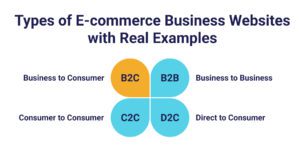How E-commerce Websites Work: A Guide for Beginners

E-commerce has redefined modern commerce, bridging the gap between businesses and consumers by offering seamless, digital-first shopping experiences. With the rapid growth of online shopping, understanding how does e-commerce works is essential for anyone looking to enter the digital marketplace.
This blog will help beginners understand the fundamental operations of an e-commerce website and how web development plays a crucial role in its success.
What is E-commerce?
E-commerce, or electronic commerce, involves the online exchange of goods and services between businesses and consumers through digital platforms. Instead of going to a physical store, customers can browse, select, and purchase products online using computers, smartphones, or tablets. Payments are made digitally, and items are delivered to the customer’s location.
E-commerce websites are online platforms where businesses and individuals sell products or services. These websites act as virtual stores, allowing customers to shop anytime, from anywhere. Web development is the foundation of these platforms, ensuring seamless user experiences, secure transactions, and efficient inventory management.
Some well-known e-commerce websites include Amazon, eBay, and Flipkart, but the scope of e-commerce goes far beyond just retail. Businesses of all sizes—whether startups or global enterprises—leverage e-commerce development to reach a global audience, increase revenue, and scale efficiently.
Key features of e-commerce websites include
- Digital storefronts: Visually appealing and easy-to-navigate layouts showcasing products or services.
- Secure payment processing: Integration of secure payment gateways ensures safe transactions.
- Inventory management: Real-time stock tracking and automated updates help businesses manage their products efficiently.
- Customer service support: Features like live chats, help centres, and FAQs help resolve customer queries quickly.
- Analytics and personalisation: Advanced analytics and AI-driven recommendations help businesses understand customer behaviour and offer customised shopping experiences.
The convenience, accessibility, and versatility of e-commerce development have contributed to its widespread adoption worldwide, making it a vital part of the modern business landscape.
How Does E-commerce Work?

Understanding how e-commerce work is essential for both business owners and consumers. A well-structured web development process ensures that every step of online shopping runs smoothly.
Here is a breakdown of its process:
Step 1: User Browses the Website
Customers begin their shopping journey by exploring an e-commerce website. They navigate through categories, search for specific products, and review detailed product pages that include images, descriptions, prices, and customer reviews.
Step 2: Adding Items to Cart
Once users find products they want to purchase, they add them to a virtual shopping cart. Some websites also offer wishlists where users can save products for future purchases.
Step 3: Secure Checkout Process
When a user proceeds to checkout, they review their order, provide shipping details, and choose their preferred payment method. A streamlined and secure checkout process guarantees a hassle-free shopping journey for customers.
Step 4: Payment Processing
E-commerce development integrates various payment gateways to facilitate transactions. Common payment methods include:
- Credit/debit cards
- UPI (Unified Payments Interface)
- Digital wallets (PayPal, Google Pay, Apple Pay)
- Cash on delivery (COD)
Step 5: Order Confirmation & Fulfillment
After a successful transaction, the website generates an order confirmation. The order details are forwarded to the warehouse or supplier, where inventory is checked, and the shipping process begins.
Step 6: Delivery & Customer Support
Customers receive tracking information to monitor their order’s progress. If they encounter any issues, they can contact customer support for assistance with returns, refunds, or exchanges.
Know More
Types of E-commerce Business Websites with Real Examples

E-commerce operates through various business models, each catering to different types of buyers and sellers. The way transactions occur can vary significantly depending on whether the participants are businesses, consumers, or a mix of both. Understanding these models is crucial for starting or growing an e-commerce venture. Below are the four main types of e-commerce business models, along with real-life examples of companies that use them effectively:
1. B2C (Business to Consumer)
In the B2C model, businesses sell directly to individual consumers. Websites like Amazon and Flipkart allow customers to browse products, make purchases, and have them delivered to their doorstep. It emphasises convenience, user-friendly interfaces, and fast transactions. This model is widespread and covers retail, food delivery, and more.
2. B2B (Business to Business)
B2B e-commerce involves transactions between companies. Platforms like Alibaba and IndiaMART help businesses purchase products in bulk from suppliers. B2B often involves large order quantities and negotiated pricing, catering to industries, wholesalers, and manufacturers.
3. C2C (Consumer to Consumer)
The C2C model allows individuals to sell to each other through online platforms like eBay and OLX. These platforms act as intermediaries, facilitating transactions by offering listing, bidding, and payment processing services. This model is popular for secondhand goods and personal items.
4. D2C (Direct to Consumer)
In the D2C model, brands sell directly to consumers without intermediaries. Companies like Nike and Warby Parker use their websites to reach customers, offering more control over branding, pricing, and customer relationships. This model eliminates third-party retailers, allowing for better profit margins.
Read More: Best Animation & UI Component Libraries for React Native in 2025
Advantages of E-commerce
E-commerce has transformed the way businesses operate and how consumers shop, offering a range of benefits that traditional retail cannot match. From providing convenience to offering insightful data for businesses, e-commerce has made shopping more efficient and personalized. Below are some of the key advantages that make e-commerce a preferred choice for both consumers and businesses:
1. Convenience
E-commerce enables customers to shop from the convenience of their homes or while on the move, around the clock. With just a few clicks, users can browse products, make purchases, and have them delivered, avoiding the need to visit physical stores.
2. Wide Selection
Online stores provide access to many products, often far greater than what is available in local brick-and-mortar shops. Customers can easily compare options, read reviews, and find niche items that may not be available in traditional stores.
3. Competitive Pricing
E-commerce platforms often offer better deals, discounts, and promotions than physical stores due to lower operational expenses. Online shopping allows customers to easily compare prices across different websites, helping them find the best value.
4. Scalability
For businesses, e-commerce eliminates the need for physical expansion. They can grow their customer base globally and increase their product offerings without the limitations of geography or space, scaling operations efficiently with minimal additional costs.
5. Data Insights
E-commerce platforms provide valuable data on customer preferences and shopping behavior, improving web development strategies. This data helps improve marketing strategies, tailor product recommendations, and enhance the overall customer experience.
Contact Us
Things You Should Be Aware of About E-commerce
While e-commerce offers numerous benefits, there are also important considerations that businesses must address to ensure long-term success. From cybersecurity to logistics, managing these challenges is crucial for maintaining customer satisfaction and complying with legal standards. Below are things you should be aware of about e-commerce:
1. Cybersecurity Risks
E-commerce businesses are vulnerable to cyber threats, such as hacking and data breaches. To protect sensitive customer data, businesses must implement secure payment gateways, use SSL certificates for encrypted transactions, and maintain strong security protocols to prevent unauthorised access.
2. Logistics Challenges
Efficient logistics and inventory management are critical for timely deliveries. Delays in shipping, inaccurate inventory levels, or supply chain disruptions can harm customer satisfaction. E-commerce businesses need to ensure that their logistics systems are streamlined to handle orders effectively.
3. Customer Trust
Building trust is crucial for the success of an e-commerce business. Consumers are more likely to purchase from websites that offer secure transactions, positive customer reviews, clear return policies, and reliable customer support. Trust enhances customer loyalty and drives repeat business.
4. Regulations & Compliance
E-commerce businesses must comply with various legal requirements, such as data protection laws (e.g., GDPR) and tax regulations. Understanding local and international e-commerce laws is essential to avoid fines and ensure smooth operations, especially when dealing with cross-border transactions.
Final Thoughts:
E-commerce is an ever-evolving industry that offers immense opportunities for businesses and consumers alike. By understanding how does e-commerce work, beginners can make informed decisions whether they are shopping online or starting their e-commerce venture. With the right web development strategies and tools, success in the digital marketplace is within reach.